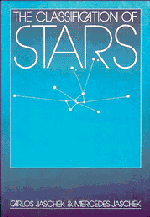16 - Further developments
Published online by Cambridge University Press: 04 April 2011
Summary
We shall examine in this last chapter some issues which are relevant to further progress in the field of classification. We shall group the issues into three sections. The first concerns the incorporation of additional information into the ‘classical’ scheme. The second is about groupings of superior hierarchical order. In the third section, we consider the future of classification.
Incorporation of new information
A question we have considered briefly in various chapters is the incorporation of new data into the classical scheme. To give an example, suppose that a large number of spectra covering the region λλ1200–3000 became available and that we are interested in a particular group of objects, for instance HB stars. In the classical region (λλ3600–4800) this is a homogeneous group (see section 10.4), but in the UV region we discover that half of the stars observed exhibit a feature at λ3040 not present in the other stars. A similar situation arises if some DC stars (i.e. degenerates having a continuous spectrum with no lines) are discovered in the UV to display carbon features. We could imagine these stars being studied in yet another region of the spectrum, for instance the 10–100 µm region, and finding there that an HB or a DC star has an infrared excess, indicating the presence of a circumstellar dust cloud.
- Type
- Chapter
- Information
- The Classification of Stars , pp. 395 - 407Publisher: Cambridge University PressPrint publication year: 1987

